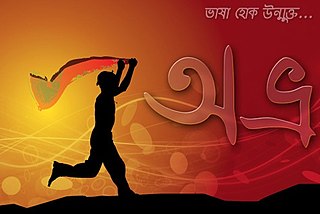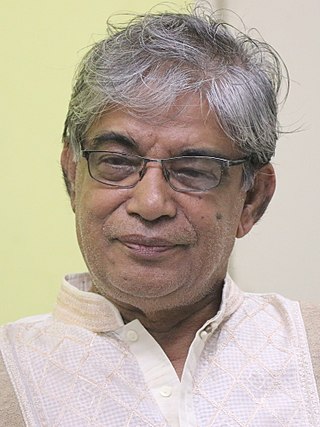Chinese input methods for computers are methods that allow a computer user to input Chinese characters. Most, if not all, Chinese input methods fall into one of two categories: phonetic readings or root shapes. Methods under the phonetic category usually are easier to learn but are less efficient, thus resulting in slower typing speeds because they typically require users to choose from a list of phonetically similar characters for input, whereas methods under the root shape category allow very precise and speedy input but have a steep learning curve because they often require a thorough understanding of a character's strokes and composition.

An input method is an operating system component or program that enables users to generate characters not natively available on their input devices by using sequences of characters that are available to them. Using an input method is usually necessary for languages that have more graphemes than there are keys on the keyboard.
The International Alphabet of Sanskrit Transliteration (IAST) is a transliteration scheme that allows the lossless romanisation of Indic scripts as employed by Sanskrit and related Indic languages. It is based on a scheme that emerged during the 19th century from suggestions by Charles Trevelyan, William Jones, Monier Monier-Williams and other scholars, and formalised by the Transliteration Committee of the Geneva Oriental Congress, in September 1894. IAST makes it possible for the reader to read the Indic text unambiguously, exactly as if it were in the original Indic script. It is this faithfulness to the original scripts that accounts for its continuing popularity amongst scholars.

The writing system of the Korean language is a syllabic alphabet of character parts organized into character blocks representing syllables. The character parts cannot be written from left to right on the computer, as in many Western languages. Every possible syllable in Korean would have to be rendered as syllable blocks by a font, or each character part would have to be encoded separately. Unicode has both options; the character parts ㅎ (h) and ㅏ (a), and the combined syllable 하 (ha), are encoded.
OpenVanilla (OV) is a free, open-source text-entry and processing architecture, and includes a collection of popular input methods and text processing filters. It serves as a bridge between input methods and the operating system. It was originally designed to offer a better text-entry experience and alternative input methods not found in Apple's built-in set or suit better the needs for Windows "switchers." However, the developers have since worked on a Microsoft Windows port and a bridge between OV and SCIM on the X Window System. The macOS version is compatible with Mac OS X 10.3 (Panther) and Mac OS X 10.4 (Tiger). OV's input methods can also be used through SCIM on Linux or FreeBSD. An experimental Win32 Unicode version is also available.

A virtual keyboard is a software component that allows the input of characters without the need for physical keys. The interaction with the virtual keyboard happens mostly via a touchscreen interface, but can also take place in a different form in virtual or augmented reality.
InScript is the decreed standard keyboard layout for Indian scripts using a standard 104- or 105-key layout. This keyboard layout was standardised by the Government of India for inputting text in languages of India written in Brahmic scripts, as well as the Santali language, written in the non-Brahmic Ol Chiki script. It was developed by the Indian Government and supported by several public and private organisations. This is the standard keyboard for 12 Indian scripts including Devanagari, Bengali, Gujarati, Gurmukhi, Kannada, Malayalam, Odia, Tamil and Telugu, among others. The InScript layout is built into most of the major operating systems including Windows, and most Linux and Mac OS systems. It is also available in some mobile phones and in Apple's iOS 5 and higher. It is available in Android 4.0 and higher but removed from latest Google Keyboard application (Gboard) and Google Indic Keyboard. It is also available for Windows Mobile 5.x and 6.x from third parties.
Indic Computing means "computing in Indic", i.e., Indian Scripts and Languages. It involves developing software in Indic Scripts/languages, Input methods, Localization of computer applications, web development, Database Management, Spell checkers, Speech to Text and Text to Speech applications and OCR in Indian languages.
Sinhala language software for computers have been present since the late 1980s but no standard character representation system was put in place which resulted in proprietary character representation systems and fonts. In the wake of this CINTEC introduced Sinhala within the UNICODE standard. ICTA concluded the work started by CINTEC for approving and standardizing Sinhala Unicode in Sri Lanka.

Unicode input is the insertion of a specific Unicode character on a computer by a user; it is a common way to input characters not directly supported by a physical keyboard. Unicode characters can be produced either by selecting them from a display or by typing a certain sequence of keys on a physical keyboard. In addition, a character produced by one of these methods in one web page or document can be copied into another. In contrast to ASCII's 96 element character set, Unicode encodes hundreds of thousands of graphemes (characters) from almost all of the world's written languages and many other signs and symbols besides.

Avro Keyboard is a free and open source graphical keyboard software developed by OmicronLab for the Microsoft Windows, Linux, MacOS, and several other software additionally adapted its phonetic layout for Android and iOS operating system. It is the first free Unicode and ANSI compliant Bengali keyboard interface for Windows that was published on 26 March 2003.

The Intelligent Input Bus is an input method (IM) framework for multilingual input in Unix-like operating-systems. The name "Bus" comes from its bus-like architecture.

A keyboard layout is any specific physical, visual or functional arrangement of the keys, legends, or key-meaning associations (respectively) of a computer keyboard, mobile phone, or other computer-controlled typographic keyboard.
Clip fonts or split fonts are non-Unicode fonts that assign glyphs of Brahmic scripts, such as Devanagari, at code positions intended for glyphs of the Latin script or to produce glyphs not found in Unicode by using its Private Use Area (PUA).

Azhagi is a freeware transliteration tool, which enables its users to type in a number of regional Indian languages, including Tamil, Hindi, and others, using an English keyboard. In 2002, The Hindu dubbed Azhagi as a tool that "stand[s] out" among various similar software "emerg[ing] nearly every other day". Since year 2000, Azhagi has provided support for Tamil transliteration; this was later expanded to nearly 13 Indian languages, featuring 16 total built-in languages as of the day of writing.

The Tamil keyboard is used in computers and mobile devices to input text in the Tamil script.

Mustafa Jabbar is a Bangladeshi businessman, technology entrepreneur and a former Minister of Post and Telecommunication in the Government of Bangladesh. He also served as the president of Bangladesh Association of Software and Information Services (BASIS). He is best known for the creation of Bijoy Bengali keyboard, which was developed in 1988, and it was most widely used Bengali input method until the release of Unicode based Avro Keyboard. He served as the president of Bangladesh Computer Samity, the national ICT organisation of Bangladesh for four consecutive periods. He is a champion of Bangla Bhasha Procholon Ain, 1987, and has been praised for promoting the Bengali language in the digital media.

UniKey is the most popular third-party software and input method editor (IME) for encoding Vietnamese for Windows. The core, UniKey Vietnamese Input Method, is also the engine imbedded in many Vietnamese software-based keyboards in Windows, Android, Linux, macOS and iOS. UniKey is free and the source code for the UniKey Vietnamese Input Method is distributed under GNU General Public License. The official website of UniKey is unikey.org, which supports both English and Vietnamese.
The Hanifi Rohingya script is a unified script for the Rohingya language. Rohingya today is written in three scripts, Hanafi, Arabic, and Latin (Rohingyalish). The Rohingya language was first written in the 19th century with a version of the Perso-Arabic script. In 1975, an orthographic Arabic script was developed and approved by the community leaders, based on the Urdu alphabet but with unique innovations to make the script suitable to Rohingya.

Meitei input methods are the methods that allow users of computers to input texts in the Meitei script, systematically for Meitei language.



































